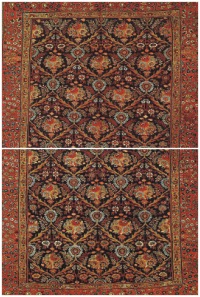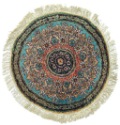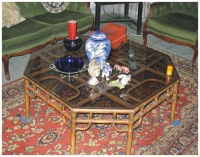

REMEMBER
Aladdin and his sweetly scented girlfriend called Jasmine from the
Arabian Nights fairy tales? That made for a great story and as all
great stories go, there had to be a big, bad and ugly villain. In
this case it was a wizard who kidnapped Jasmine and like all other
bad guys he locked her up in a tower. The distraught Aladdin luckily
had something better than the inefficient police to help him out.
His friend was a genie called Genie who provided him with something
that he could use to rescue the sweetheart from the tower in style.
It was a flying carpet. The girl was rescued amidst fireworks, a blasting
rock soundtrack and plenty of highflying acts. As you know, they lived
happily ever after.
Well,
there are no genies and no magical flying carpets as such but the
fact remains that carpets do have a certain magic. Carpets can transform
a drab room into something to be admired. The right colour and style
can accentuate the beauty of an already smart looking room.
The
history of carpets is a bit of a mystery. A lot of it is tied up in
guesswork and assumptions from certain facts. European researchers
believe that the Egyptian and Assyrian civilisation was the cradle
of carpet weaving. It is presumed that the early carpets were similar
to felt and primitive textile products. As a result these did not
last and researchers cannot pinpoint the exact time when carpets came
into existence.
Stepping
through time
A symbol of artistic magnificence is the Persian carpet. The Iranians
were among the pioneer weavers of the ancient civilisations. The carpet
business was a family tradition where the fathers handed down the
knowledge to the sons who perfected the techniques further and handed
them over to their sons. The processes thus became closely guarded
family secrets.
 To
trace the history of the Persian carpet is to trace the history of
one of the greatest civilisations ever known. The carpets started
out from simple articles of need to cover the floors and walls of
tents belonging to nomadic tribesmen. This protected them from the
cold and damp. The increasing beauty of these articles found new owners
in kings and noblemen. Researchers found the earliest existing Persian
carpet during excavations of burial mounds in the Altai Mountains
of Siberia in a place called Pazirik. Another rug found in the same
area dates back to the first century BC. From the 3rd to the 7th AD
during the Sassanian dynasty Persian carpets won great acclaim as
they were being exported to many other parts of the country. The fall
of the dynasty in the following centuries led to a decline in the
markets for such carpets. A similar rise and fall followed the Mughal
invasion. These are believed by researchers to be the culmination
of the best carpet design techniques. Two of the best-known carpets
come from the mosque of Arbil dated 1539. The larger of the two is
kept in London's Victoria and Albert Museum while the other is in
the Los Angeles Country Museum. Rugs of distinctive beauty were also
woven in Kashan, Yazd, Kerman and Fars.
To
trace the history of the Persian carpet is to trace the history of
one of the greatest civilisations ever known. The carpets started
out from simple articles of need to cover the floors and walls of
tents belonging to nomadic tribesmen. This protected them from the
cold and damp. The increasing beauty of these articles found new owners
in kings and noblemen. Researchers found the earliest existing Persian
carpet during excavations of burial mounds in the Altai Mountains
of Siberia in a place called Pazirik. Another rug found in the same
area dates back to the first century BC. From the 3rd to the 7th AD
during the Sassanian dynasty Persian carpets won great acclaim as
they were being exported to many other parts of the country. The fall
of the dynasty in the following centuries led to a decline in the
markets for such carpets. A similar rise and fall followed the Mughal
invasion. These are believed by researchers to be the culmination
of the best carpet design techniques. Two of the best-known carpets
come from the mosque of Arbil dated 1539. The larger of the two is
kept in London's Victoria and Albert Museum while the other is in
the Los Angeles Country Museum. Rugs of distinctive beauty were also
woven in Kashan, Yazd, Kerman and Fars.
The
art of utilising gold and silver thread was also developed during
this period. A magnificent example is the coronation carpet kept in
the Rosenberg Castle in Copenhagen. Persian carpets have received
international acclaim for their distinctive and spectacular artistic
accomplishments. These are among the most treasured possessions in
homes and offices all over the world.
The
Kashmir carpet is also another famous example of artistic excellence.
It started in the early 15th century when king Zain-ul-Abedin (Badhsah)
brought master carpet weavers from Persia. He introduced the assembly
line in factories for weaving, clipping and washing.
Many
experts say that the Iranian carpets are not famous for their colours
but on account of their durability and weaving technique. The most
beautiful examples come from Farallan, Kurdistan, Hamedan, Malayer,
Arak, and Naharvand. 50 percent of the rural families in these regions
are engaged in carpet weaving. Most of the weavers are women. Some
of these carpets deteriorated in quality due to the use of ready wool
with chemical dyes. The piles are often long and carpets are thick.
The preferred colours are blue, indigo and a wide range of greens.
The climatic conditions are rather harsh with long winters encouraging
the villagers to indulge in such handicrafts.
 The
allure of the golden fibre
The
allure of the golden fibre
Bangladeshi jute carpets are primarily made from the golden fibre
jute. Jute is one of those amazing fibres that have tons of different
uses. One of the wider purposes it serves is that for weaving carpets.
This golden fibre was used by the BJMC (Bangladesh Jute Mill Corporation)
to produce its finest. Most of the carpets had a 10mm pile. Wall hangings,
door mats and rugs were also produced. At present most of the carpet
factories are closed down due to availability of raw materials, flooding
of the market by foreign goods and lack of funds. The government does
close to nothing to maintain this industry. As a result it is soon
going to become just a symbol of heritage in the pages of history.
The
right carpet at the entrance to a house plays a role in creating a
proper first impression. It proposes a particular invitation to a
visitor as well as acting as eye candy for the dwellers. For tasteful
décor the city dwellers can go to Elephant Road, Purana Paltan
and Gulshan. BJMC has a display centre in the Adamjee Court Building
in Motijheel. The local items cost between 3, 000 to 10, 000 taka.
Solid colours are about 20-25 taka per square foot. On the other hand,
foreign goods are available being mostly synthetic and slightly higher
in price. These are lighter and easier to maintain. The prevalent
designs are floral or geometric motifs.
Iranian
carpets
The classic Iranian carpets are now available in Dhaka. These are
created using state of the art techniques with synthetic materials.
Hand woven Iranian carpets and rugs are the objects of desire for
many. Persian carpets can be divided so far as design is concerned,
into two main groups. Carpets with a geometric design and carpets
with curvilinear patterns, known as floral carpets. Nature supplies
the greatest inspiration to the Persian carpet designer. With faithful
representations of trees, flowers, birds and clouds, which, through
the creative and the innovative genius of Persian art, became more
and more stylised with each succeeding generation. Carpets with geometric
designs are woven by nomadic tribes with particular motifs and designs.
The
intricate designs charm just about everyone, which is why the Iranian
stalls at the annual trade fair attract huge crowds, most of whom
are looking for carpets. The Iranian Emporium situated in the Tejgaon-Gulshan
link road offers both traditional woollen carpets as well as modern
synthetic ones. The prices start from 4500 taka to a wallet denting
two lakhs or even more. Whole sets can be bought to match bedroom,
living room etc.
Carpets
of Kashmir
Kashmir is famous the world over for the beautiful hand woven carpets.
Basically brought to India by Muslim traders it strongly reflects
Persian motifs and styling. These exquisite creations are hand knotted
in accordance to a strict code of colours. The order in which the
colours have to appear is lyricised in a song or mantra, which the
weavers hum while they do the work. Kashmiri carpet designs are usually
written down on paper in a kind of shorthand style called talim, a
practice derived from the traditional methods used for making kani
shawls.
Satranji
Satranji is an ancient technique for weaving rugs. It was in great
demand during the 18th century in the Mughal courts. In Rangpur many
of the families were involved in this business. In 1829 the DC of
Rangpur was a man named Nishbeth. He was amazed by the craftsmanship
and did a lot to promote the business. That's why that region is named
after him.
 The
post liberation war era saw a decline in the trade. But in the last
decade the trade has seen a revival thanks to Shafikul Alam Selim.
He has introduced new techniques to revive the ancient trade and in
the process he has provided employment for over 300 families. Satranji
is marketed as a brand name with a display centre in Dhaka located
at Shukrabadh. The designs include a wide array of motifs such as
fruits, elephant footprint, geometric shapes, plain with fancy borders
etc. These are made of a combination of jute, wool and cotton using
chemical dyes.
The
post liberation war era saw a decline in the trade. But in the last
decade the trade has seen a revival thanks to Shafikul Alam Selim.
He has introduced new techniques to revive the ancient trade and in
the process he has provided employment for over 300 families. Satranji
is marketed as a brand name with a display centre in Dhaka located
at Shukrabadh. The designs include a wide array of motifs such as
fruits, elephant footprint, geometric shapes, plain with fancy borders
etc. These are made of a combination of jute, wool and cotton using
chemical dyes.
Cosmetic
surgery?
Carpets are subjected to a lot of torture from our feet as well as
spilled food, water, baby droppings and tons of other types of oppression.
As a result the colours look faded. Elephant Road has scores of shops
that wash and dye old carpets to bring out a new shine. It is also
done along the footpaths of the Motijheel T&T colony. They charge
about 500-800 takas, depending on the size. However they only wash
the synthetic carpets, as it is light and simpler to wash than the
heavy jute carpets. Professional cleaning is required for hand woven
carpet but not more than once in every one or two years.
Wrap-up
Carpets were once the treasures of royalty. After many generations
it has come into the hands of the common people to step on and wreak
all kinds of havoc. The right combination could transform your room
into a piece of art. It's an essential piece for anyone who wants
to beautify his or her abode.
By
Sultana Yasmin
Translated by Ehsanur Raza Ronny
Photo: Zahedul I Khan
Acknowledgement: Iranian Cultural
Center, Dhaka

